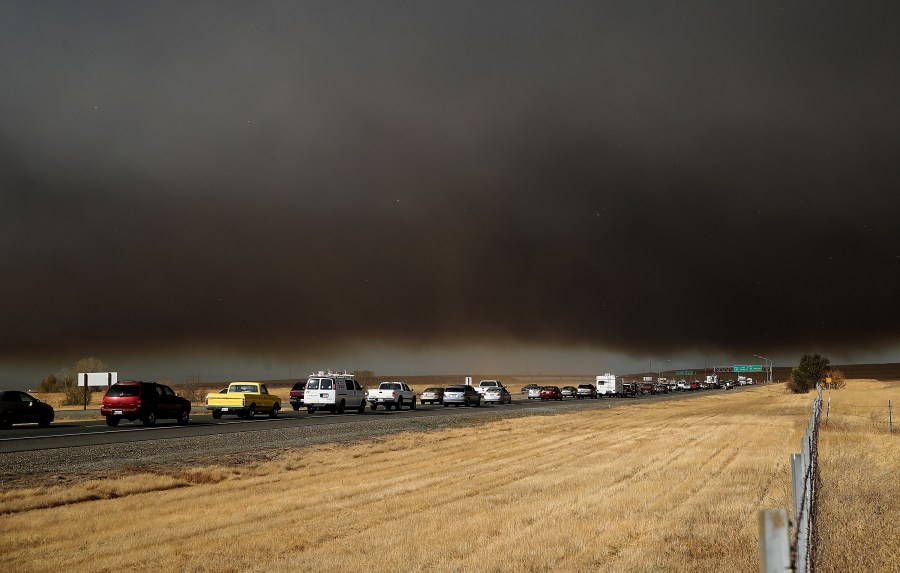As climate change brings more fires, how do we keep the air clean?

This story is part of How We Survive, “Marketplace Tech’s” series on the role of technology in helping humanity weather climate change.
Last year’s Camp Fire in Northern California was the worst America has seen in a century. It decimated the town of Paradise, destroyed 18,793 structures and killed 85 people, and there were widespread effects beyond the burn zone.
Smoke filled the sky and created a creepy orange haze that stretched some 200 miles to San Francisco. The entire region was measured as having the dirtiest air in the world for a time. Schools and businesses closed. Officials told everyone to stay inside.
Climate change means wildfires will get worse. The season for them will get longer. And that means more smoke in the air — especially dangerous for children, older people and those with existing health complications like asthma. When fires burn inhabited areas, the smoke contains toxins from burning plastics, cars, treated wood and more.
Jeff Williams, with the California Air Resources Board, notes that wildfire smoke carries tiny particles, smaller than 2.5 microns.
“That is about one-twentieth the width of a human hair,” he said. “These are the particles that are easily respirated into the lungs and actually can be pulled fairly deeply into the lungs.”
With more days of smoke-filled air outside, there’s a greater need to figure out how to clean the air inside homes, schools and offices.
FLEXLAB (which is an acronym for Facility for Low-Energy Experiments in Buildings) is part of the Lawrence Berkeley National Laboratory. There, researchers are focused on figuring out solutions for better indoor air quality.
The lab is made up of two rotating garage-sized buildings that pivot to follow the sun. Inside, they experiment with ventilation and airflow.
In the United States, a lot of outside air is cleaner than inside air, said FLEXLAB senior scientist Mary Ann Piette. Inside, we cook, we have mold, we sweat and expel carbon dioxide. One part of the tech challenge is that recirculated air is full of carbon dioxide, which can impair thinking (not a good thing for offices).
When it’s really smoky out, you’re supposed to close windows tightly, change filters in your heating and cooling systems, and vacuum and wipe down surface that might have smoke particles on them. But in the future, that might not be enough.
“In extreme smoke, you may want zero outside air, and it’s 100% recirculated,” Piette said. “That’s certainly what they do in spaceships. If you think about NASA — they had to clean the air. So a lot of this technology has been developed in submarines, things like that.”
FLEXLAB is testing materials that grab carbon dioxide molecules out of the air, so buildings could run on totally recirculated air for periods of time.

On the residential side, you can buy an air purifier for your home that will do something similar, though some models cost hundreds of dollars.
At the moment, most people would do fine with a high efficiency mechanical filter on their air conditioners and heating units, said Williams with the California Air Resources Board. They’re generally not as expensive. But everyone should invest in something.
“The people that will benefit most immediately are those sensitive populations,” he said. “But the reality is that we’ll all benefit from cleaner homes.”
AccuWeather estimated the total cost of the Camp Fire at $400 billion. As more people are exposed to wildfire smoke and develop health problems from it, a larger share of fire damage will be made up of those medical costs.
Related Links: More insight from Molly Wood
The lost lives, homes and businesses are the worst effects of last year’s Camp Fire, by far. In Oakland, where I live, I can tell you that the smoke was horrible.
BuzzFeed did a story back in November during the Camp Fire about how protective mask selfies had become a trend in the Bay Area, a dystopian sign of our times.

I took part in the trend, as you can see here.
Masks have become a big part of the smoke story, and there was a lot of advice being shared about how and when to use them. (By the way, putting one on to go running is not a good idea.)
But Williams from the California Air Resources Board told us masks should be part of the toolkit if you have to be outside on smoky days.
As for future fires, Time had a story in January about how California fire departments are trying to upgrade their tech to create digital maps of fire-prone areas.
And they’ve developed an entire system of satellite data analysis that uses artificial intelligence to predict where fires might go once they’ve started.
Wildfires are even contributing to the emissions that cause climate change. Huge fires have been raging in Siberia and across the Arctic since June. Scientists say they’re unprecedented in those regions.
And a CNN story last week shows giant sinkholes forming in Siberia as permafrost melts there, potentially threatening entire towns.
The future of this podcast starts with you.
Every day, the “Marketplace Tech” team demystifies the digital economy with stories that explore more than just Big Tech. We’re committed to covering topics that matter to you and the world around us, diving deep into how technology intersects with climate change, inequity, and disinformation.
As part of a nonprofit newsroom, we’re counting on listeners like you to keep this public service paywall-free and available to all.
Support “Marketplace Tech” in any amount today and become a partner in our mission.

















